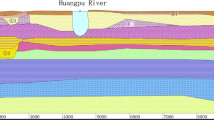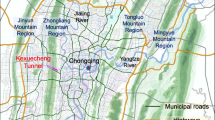Abstract
Subway traffic is now being developed in China on a large scale and the planning subway stations are often located in dense district with tall building. The dewatering of confined aquifer may cause ground settlement, the cracking, deformation and tilting of the building, and even collapse. Combing with the dewatering project of environment protection of the pit of Yishan Road station of Shanghai subway No. 9, through the inversion of seepage parameters based on the field pumping test, the hydraulic barrier function of the underground continuous wall is simulated. The result indicates that with the reduction of the exposed length of the filter tube and the increase of that enclosed, the drawdown of the confined aquifer decreases. Especially with the increase of the enclosed length of the filter tube, the drawdown outside the pit can be controlled effectively. According to the result of the numerical simulation, the design of the continuous concrete wall of the pit for Shanghai Subway No. 9 is altered and the depth of the continuous concrete wall of the standing part and that in the end well are increased to 61 and 62 m, respectively. The monitored result of the equal drawdown pumping test indicates that the drawdown outside the pit with a distance of 1–6 m to the wall is less than 2 m; It means that there is nearly no influence on the environment around the pit during dewatering.










Similar content being viewed by others
References
Shi Y (2004) The 3-D finite element analysis for unsteady seepage in excavation engineering. Thesis submitted to Tianjin University for the Degree of Master of Engineering in Science
Wu LG et al (2003) Design and construction of dewatering engineering and theory of pit seepage. China Communication Press, Beijing
Wang GG, Yan P, Gong XN, Wang CH (2001) Research on the seepage field of excavation with waterproof structure. Ind Constr 31(4):43–45
Yu HL, Lu JF, Li SD (2002) Study on seepage field characteristics of foundation pit excavation. J Zhejiang Univ China (Science Edition) 29(5):595–600
Zhang JX, Li L, Zhang BS (2002) 3D calculation and analysis of seepage in pit dewatering. Geotech Eng Field 5(5):50–51
Acknowledgments
This work presented in this paper was supported by the research grant (No. 50579097) from National Natural Science Foundation of Ya Longjiang hydropower of China, the research grant (No. 062012004) from Scientific Climbing Plan of Shanghai Science Committee of China and the research grant (No. 2006CB403200) from National Basic Research Program of China.
Author information
Authors and Affiliations
Corresponding author
Rights and permissions
About this article
Cite this article
Wang, J., Hu, L., Wu, L. et al. Hydraulic barrier function of the underground continuous concrete wall in the pit of subway station and its optimization. Environ Geol 57, 447–453 (2009). https://doi.org/10.1007/s00254-008-1315-z
Received:
Accepted:
Published:
Issue Date:
DOI: https://doi.org/10.1007/s00254-008-1315-z




